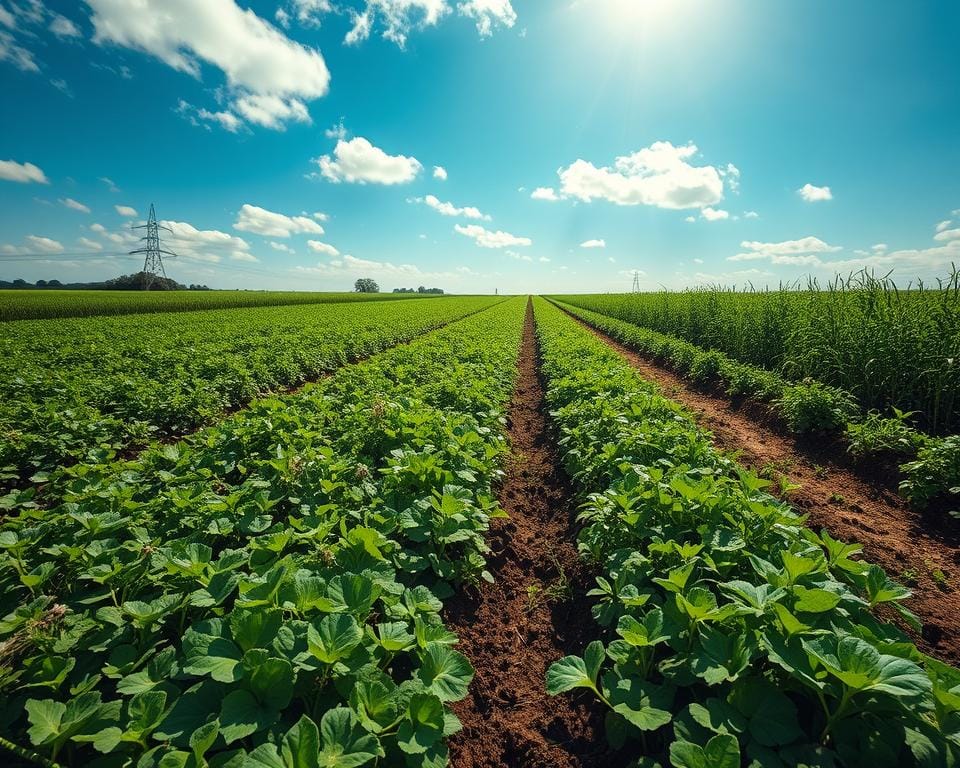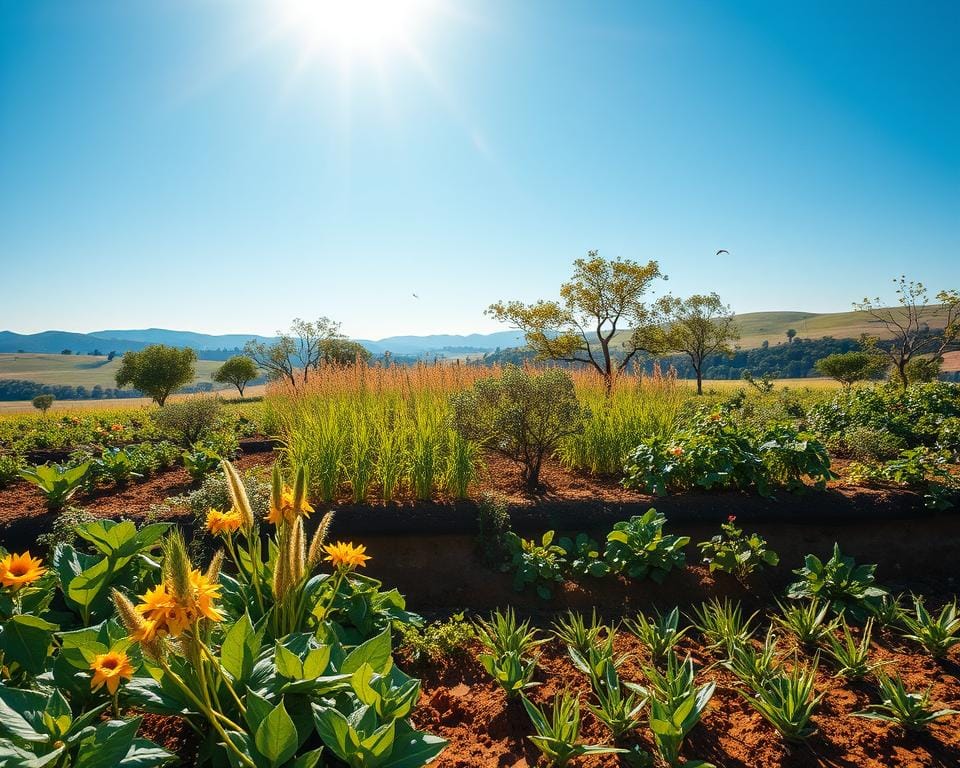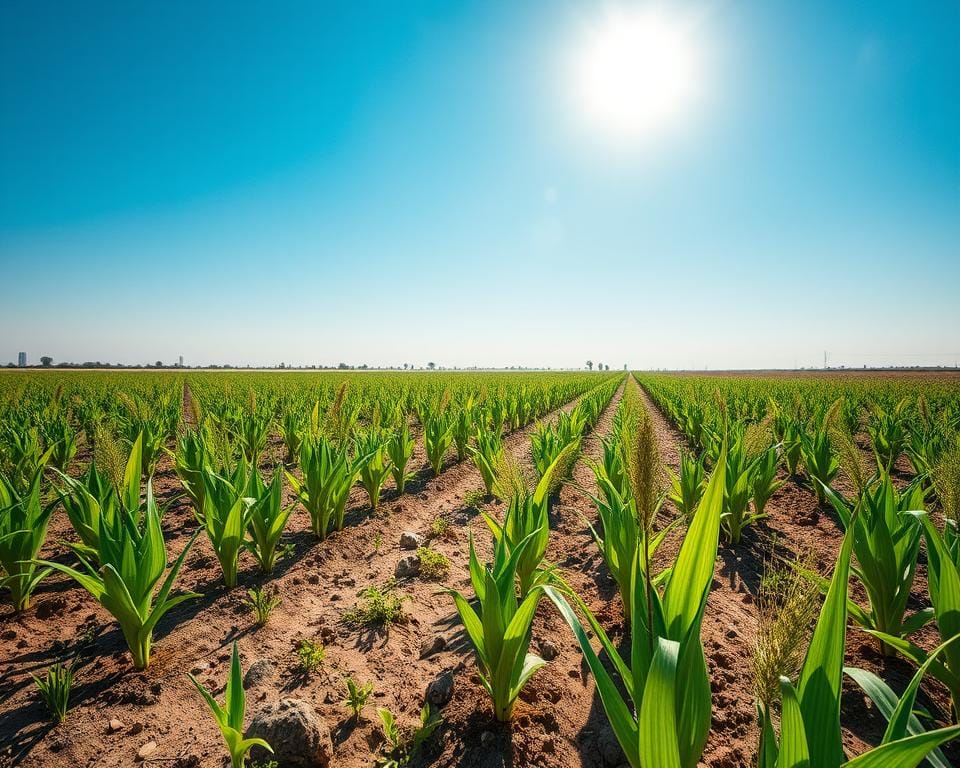Small-scale farmers deal with big problems. They must switch to sustainable farming methods to grow more crops. Using smart tools like precision irrigation, crop rotation, and mixed planting helps a lot. This way, farms can produce more and stay healthy in the future.
Drought-resistant farming helps keep the soil healthy and saves water. This is very important in dry areas. These methods make farming better for the environment and help farmers deal with less water. With more droughts happening, these smart farming ways are key to a better farming future.
About 50% of the land with plants is used for farming. This means there isn’t much space left to use. So, using the land better is crucial. Now, farmers use high-tech tools like GPS and drones. These help use less water while growing more crops.
Also, scientists are creating crops that can handle drought well. These tough plants can take the heat and other weather issues. Plus, growing different kinds of plants together can help. This makes farms stronger against bad weather. To help, governments are giving farmers money and support to farm this way.
Putting money into good farm setups and giving farmers the latest weather news is important. This helps farmers make better choices. By supporting these drought-resistant methods, we’re making farming ready for what’s coming. It’s about keeping farming strong and sustainable for the future.
Precision Irrigation Systems
Precision irrigation systems are key in fighting drought in farming. They use advanced tech to deliver water right to the roots. This cuts down waste and saves important resources. Using these systems helps farms be more water-efficient, keeping plants healthy by giving them water exactly when needed.
Drip Irrigation
Drip irrigation stands out in precision irrigation. It slowly brings water straight to plant roots, cutting down on evaporation. Studies show it improves water use and crop growth. Farmers using this tech can better handle their water, helping them keep up production, even in dry areas.
Soil Moisture Sensors
Soil moisture sensors play a big part in precision irrigation. They give live updates on soil moisture, guiding farmers on when to water. This smart watering is key to saving water and keeping plants healthy. Adding these sensors helps farmers water more efficiently and push forward sustainable farming tech.
Traditional watering methods often don’t consider the different needs of crops and soils. But, precision irrigation, including drip systems and soil sensors, does. These methods make smart watering possible for today’s farms. They help us tackle water shortage globally, keeping farms productive and strong.
Cover Cropping Techniques
Using cover crops, like clover and alfalfa, is key to healthy soil. These plants help by adding nitrogen from the air into the soil, keeping weeds away, and holding onto moisture. This leads to richer soil, which means plants grow better and give more back, all while needing fewer chemicals. Plus, cover crops prevent soil from washing away and improve the soil, making it better at soaking up water. This helps the farm’s environment thrive.

Protecting and Enriching Soil
Cover crops are critical for protecting soil. They add important nutrients that help crops grow well. This makes the soil ready for future farming and keeps it healthy. Check it out here.
The VACS program helps farmers afford these helpful plants. This reduces costs and promotes using cover crops for a better farm.
Reducing Soil Erosion
Cover crops play a big role in stopping soil loss. They keep the soil fertile and ready for growing. These plants cover the ground well, shielding it from rain and wind that can wear soil away. This approach is part of many conservation efforts, like the VACS program. It shows how important managing soil is for farming’s future.
- Drip irrigation can deliver water directly to the soil at optimal intervals, maximizing usage efficiency.
- Farmers can use mulch to prevent the soil from drying up during the off-season.
- Aquaponics saves up to 95% of water compared to traditional methods.
Combining cover crops with these techniques boosts water and nutrient levels. It also makes soil stronger against climate changes. Virginia State University’s Small Farm Outreach Program helps farmers learn and apply these practices. This support is crucial for success.
| Technique | Benefit |
|---|---|
| Nitrogen Fixation | Enriches soil with essential nutrients |
| Weed Suppression | Reduces competition for resources |
| Soil Moisture Retention | Improves water efficiency and availability |
| Soil Erosion Reduction | Maintains soil structure and health |
Drought-Resistant Crop Varieties and Technological Advancements
Modern agriculture faces a big challenge with the driest spell in over a millennium hitting the American Southwest. Drought-resistant crops are now essential. Thanks to genomics and gene editing, we can create crops that tolerate harsh conditions. This ensures we have enough food. These innovations also lead to more productive and tough farming practices.
High-Yield Crop Varieties
High-yield crops are designed to be both tough against climate change and bountiful. With the cost of fertilizers and crop protection soaring globally, investing in these crops helps make farming better for the environment. Using advanced breeding and DNA sequencing, we get crops that yield more and resist drought better.
Technological Advancements
Advances in farming technology are changing the game in agriculture. Agriculture 4.0 brings in IoT, robotics, AI, and blockchain to make farming sustainable and efficient. Tools like soil sensors and analytics give farmers data for better decisions. Adding renewable energy sources, like solar and wind power, reduces farming’s impact on the climate. These tech advances help us deal with climate change and increase farm productivity.
| Technological Advancements | Benefits |
|---|---|
| Precision Farming Technology | Optimizes resource use, increases yield, reduces waste |
| AI and Predictive Analytics | Accurate weather predictions, smart crop monitoring, efficient pest management |
| IoT Devices and Sensors | Real-time soil, weather, and crop health monitoring |
| Genomics and Gene Editing | Development of climate-resilient crops, improved nutritional content |
| Renewable Energy Technologies | Reduction in fossil fuel dependence, lowered greenhouse gas emissions |
Polyculture and Crop Rotation
Polyculture farming mixed with crop rotation can greatly help farms last longer. They make this happen by growing several crops in one area and changing crops every year. This keeps the soil healthy and keeps pests away. Doing these things together boosts the land’s health by bringing in more types of life and cutting down on harmful chemicals.
Maintaining Soil Health
Using both polyculture and rotating crops makes the soil healthier and richer. A method called the “Three Sisters” plants different crops close together, which helps everything live in harmony. By changing up the crops, we stop diseases and get perks like less soil erosion and better soil.
- Crop rotation improves soil by adding plants like alfalfa and clover, which pull nitrogen from the air.
- Plants used for green manure, like legumes and grasses, boost soil fertility and the amount of organic material.
- Cover crops, including clovers and rye, add to the organic matter in the soil and help water soak in better.
Keeping this cycle going makes crops need fewer outside resources, which is better for the soil. Systems of rotating crops, like the old four-field system, encourage keeping things sustainable. They help with growing more crops and keeping water in the soil.
Enhancing Farm Biodiversity
Using many types of plants in polyculture farming makes farms stronger and more diverse. More types of plants mean more good insects and natural enemies of pests come around, which lessens the need for harsh bug sprays. This way, pests are less of a problem, and the plants are healthier.

Also, mixing up crops with smart rotation keeps the soil rich and ready for more planting. Farmers have always known swapping crops like grain and beans helps put nutrients back into the soil. This keeps farming going strong. Using these ideas widely can help farms adapt to new challenges and grow different kinds of crops well.
- While row crops can be valuable, they might harm the soil, so it’s key to balance them with soil-helping legumes.
- Using beans for green manuring can lead to more crops later without needing harsh fertilizers.
- Old rotation ways, like those suggested by George Washington Carver, are great at keeping the soil fertile.
Starting to use polyculture and rotating crops not only keeps farming going but also ensures a lasting future for farms all over our planet. For example, these methods have cut down soil erosion and added more life variety in places moving away from older farming ways.
| Practice | Benefit | Example |
|---|---|---|
| Polyculture | Improves biodiversity and pest control | Three Sisters planting |
| Crop Rotation | Breaks pest and disease cycles | Four-field system |
| Green Manuring | Enhances soil fertility | Legumes and grasses |
Vertical Farming for Space Efficiency
Vertical farming is changing how we use space for farming in cities. It uses upward space instead of spreading out. This increases how much food we can grow in a small area. It’s especially useful in dry areas where water is scarce and traditional farming is hard.
Urban Farming Solutions
Urban vertical farming is a top choice for city agriculture innovations. Companies like Eden Green Technology lead by example. They use 98% less water and 90% less energy for lights than normal farms do. They also prevent harm to the soil.
Vertical farms cut down on the need to transport food over long distances. This saves money and is better for our planet. They also produce a lot more food from the same area than traditional farms, making them super efficient.
High-Value Crops
It’s especially good for growing valuable crops that don’t need much space, like herbs and leafy greens. For instance, AeroFarms grows 390 times more per square foot each year using 95% less water. This shows how productive vertical farming can be.
Eden Green Technology harvests 2,500 tons of leafy greens every year. Their crops are ready to pick in just 28 days. To discover more about water-saving agriculture, visit the Halo 5 water system site. It has a lot of information on water efficiency.
Conclusion
Using drought-resistant farming methods can greatly improve how we farm. Techniques like precision irrigation keep our water use efficient. They help fight the impact of drought on farms.
Cover cropping and rotating crops keep the soil healthy and stop erosion. This makes our agriculture stronger against droughts. Introducing drought-resistant crops and using new technology are key. They help us farm smartly and sustainably.
High-yield, drought-resistant crops can boost farm productivity by up to 25%. Vertical farming uses 90% less water than old methods. Though it’s costly at first, it cuts down on transport costs and emissions a lot.
We need farmers and leaders to work together on these methods. Their use should grow all over. This way, we can reduce the harm droughts do to our food supply and farmers. Drought-resistant farming is a team effort for a greener earth.
To learn more, check out these advancements in making farming tougher against drought.

